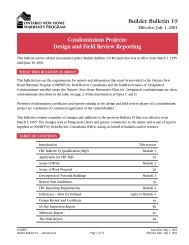Homeowner Information Package - Tarion
Homeowner Information Package - Tarion
Homeowner Information Package - Tarion
You also want an ePaper? Increase the reach of your titles
YUMPU automatically turns print PDFs into web optimized ePapers that Google loves.
<strong>Homeowner</strong> <strong>Information</strong> <strong>Package</strong><br />
19<br />
How can I control moisture?<br />
<strong>Tarion</strong> recommends that new homeowners<br />
always use their home ventilation system to control<br />
moisture. Here are some extra tips you can follow<br />
to help prevent moisture damage to your home.<br />
Outside the home<br />
1) Keep flowerbeds or landscaping at least six<br />
inches or 150 mm away from the top of the<br />
foundation and do not change the direction<br />
of the grading or the slope of the ground away<br />
from the house. Placing soil near or above<br />
the top of the foundation allows moisture to<br />
come into direct contact with the structure<br />
of the building.<br />
2) Clear eavestroughs of debris regularly and<br />
extend downspouts so that water is directed<br />
away from the building. Water flow can erode<br />
the ground near the foundation and create<br />
depressions where water collects. Standing<br />
water near the foundation can force its way<br />
into the basement.<br />
3) Inspect the caulking around windows and<br />
doors and on the roof to ensure it hasn’t<br />
become cracked or separated.<br />
4) Have your roof inspected regularly to ensure<br />
shingles, flashing and chimney caps are in<br />
place and sealed properly.<br />
Inside the home<br />
1) Purchase a “hygrometer” to monitor the<br />
relative humidity in your home.<br />
2) When using a humidifier or dehumidifier, be<br />
sure to follow the manufacturer’s instructions.<br />
In the winter, keep the relative humidity in<br />
your home in the range of 30-45%. Lower<br />
humidity levels may affect your health and<br />
cause things made of wood to shrink. Excess<br />
humidity can cause condensation on windows<br />
and damage the surrounding wall. In the<br />
summer, dehumidify the basement to avoid<br />
condensation build-up on the cool foundation<br />
walls. Relative humidity levels should not<br />
exceed 60%.<br />
3) Work with your builder to ensure that leaky<br />
pipes and fixtures are repaired immediately.<br />
Clean and completely dry any areas that are<br />
dampened or wet within 48 hours.<br />
4) Store organic materials such as newspapers,<br />
cardboard boxes and clothes away from cool,<br />
damp areas to prevent moisture build-up.<br />
Keep storage areas tidy so that air<br />
circulates freely.<br />
5) If you are adding a hot tub to your home,<br />
or have a large collection of plants, consider<br />
the amount of moisture they will add to your<br />
indoor air and ventilate accordingly.<br />
6) Never vent your clothes dryer inside your home.<br />
7) Investigate and identify any musty smells and<br />
odours. They are often an indicator that there<br />
is a hidden moisture problem.<br />
We have included a Home Maintenance Checklist<br />
in this booklet (on the following pages) to guide<br />
you through your annual maintenance routine.<br />
The checklist provides a monthly breakdown<br />
of items for inspection, and is intended to help<br />
you set up a regular schedule of check-ups<br />
and clean-ups.










